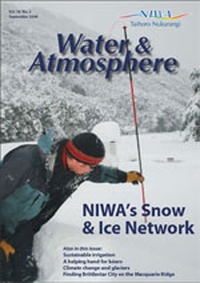Alien amphipod: hitchhiker of the sea
In New Zealand, Caprella mutica has been found attached to structures in ports and aquaculture farms, such as this line in a mussel farm. (Photo: Chris Woods)
Blending in with the background, a female with full brood pouch hangs from a string line, awaiting a passing meal. (Photo: Chris Woods)
Body parts and relative sizes of adult Caprella mutica male and female. (Photo: Kate Willis and Thom Nickell, Scottish Association of Marine Science)
At only 3 cm long, the male Caprella equilibra, a caprellid common in New Zealand, is dwarfed by the male Caprella mutica, which can grow to 5 cm. (Photo: Chris Woods)
Chris Woods, Graham Fenwick, and Kate Willis give us the lowdown on a marine invader that could be bad news, but may also prove beneficial.
It looks like a starved praying mantis and specialises in hitchhiking across the oceans. The Japanese skeleton shrimp, Caprella mutica, is a marine amphipod that has spread around the globe from its native home in northeast Asia. Soon you may find it in a harbour near you, because its latest port of call is New Zealand.
Global invader
Caprella mutica was first described from northeast Asia, but, in the last 40 years, it has spread throughout the Northern Hemisphere. It has recently been identified in New Zealand coastal waters – its sole known Southern Hemisphere destination to date.
Outside its native Asian range, C. mutica has been found only in places like ports, aquaculture facilities, and oil rigs. Its long-distance travels probably occur via ships (in ballast water or as hull fouling) or through aquaculture activities. We know that its spread occurs along multiple routes, and the amphipod may use numerous ‘stepping stones’ as it moves from place to place. Short-distance travel is most likely via recreational boating, drift seaweed, passive drift, and aquaculture.
So far, in surveys of non-indigenous marine organisms we’ve conducted for MAF Biosecurity New Zealand, and in aquaculture-related research, we’ve recorded C. mutica at three South Island locations: Lyttelton Harbour, Timaru Harbour, and Pelorus Sound in the Marlborough Sounds. Significant populations of the caprellid have shown up on wharf pilings, vessel hulls (including recesses around seawater intake and discharge valves), and aquaculture structures, notably mussel ropes and finfish cages. C. mutica has also been observed hitching a ride on several New Zealand decorator crab species, a novel localised caprellid dispersal mechanism.
Giant caprellids
Caprella mutica belongs to a peculiar group of marine amphipod crustaceans. On close examination, these unusual invertebrates look like a cross between a praying mantis and a stick insect. The head has two pairs of antennae and the body has multiple segments (pereonites), most with a pair of limbs (pereopods). Caprellids have long, thin bodies, and greatly reduced abdomens. Their typical posture is standing erect, swaying in the current, and holding their enlarged second claws (gnathopods) in a mantis-like pose, ready to grab passing prey. They blend in well, as their body shape and colour often match the background. Mature C. mutica are distinguished from native New Zealand caprellids by their large size (males can reach 5 cm length) and the numerous spines along their backs.
Adaptable and productive
Adult C. mutica are normally found in seawater with temperatures ranging between –1.8 °C and 26 °C and salinities greater than 20 parts per thousand. They are opportunistic feeders, consuming everything from suspended particles of decaying plants and animals to diatoms, macroalgae, other crustaceans, and farmed salmon food. This species can reproduce within a month of hatching, and large females can produce over 300 eggs in a single brood. Reproduction can occur year-round, but is typically greatest in spring and summer, when populations can explode. In New Zealand, we have observed densities of 180 000 caprellids per square metre. Even higher densities have been recorded on a salmon farm in Scotland (319 000 per m2). This alien species is now well established outside its original range. With its wide environmental tolerances, rapid growth, early reproduction and high population densities, variable feeding habits, and penchant for settling on artificial structures and vessels, it is likely to become widespread in New Zealand.
Food for the masses
As a result of their high densities and reproduction rate, caprellids may form an important food source for various fish species and other invertebrates, such as crabs, anemones, and nemertean worms. They have been identified as a major dietary component of the New Zealand seahorse, Hippocampus abdominalis. Despite their slenderness, caprellids are an excellent food because they contain relatively high levels of beneficial polyunsaturated fatty acids and carotenoid pigments; they make a nutritious snack for a diverse range of marine predators.
Impacts on the marine environment
What, if any, impact will this invader have on New Zealand’s marine biodiversity? Some caprellid species dominate others due to their larger size, greater density, and aggressiveness. C. mutica appears to dominate other amphipod species on artificial structures, but not in natural reef habitats. Mature male C. mutica are very aggressive; their underwater boxing matches are fascinating to watch (it looks rather like handbags at dawn). Thus, C. mutica could potentially displace smaller, less abundant native caprellids in New Zealand through their rapid reproduction, high population density, large size, and aggressive behaviour.
As yet, the impacts of this caprellid in our waters are unknown, although there may be some positives to its presence. High densities of this species on artificial structures could improve the condition of local predatory fishes compared with those feeding among adjacent natural reef habitats. Even farmed salmon may feed on caprellids inhabiting their cages, adding a natural, although minor, component to their otherwise artificial diets.
Teachers’ resource for NCEA Achievement Standards or Unit Standards:
Biology Level 3 AS90713, US6315






